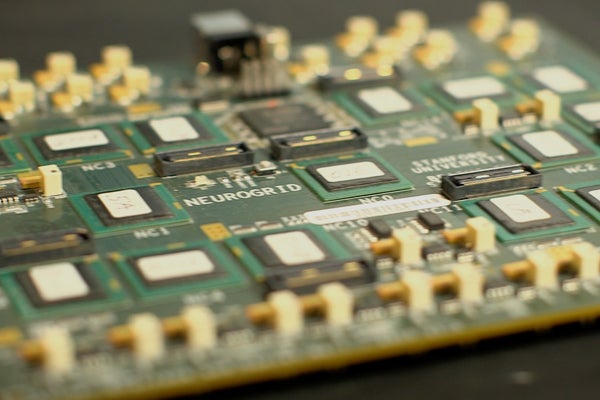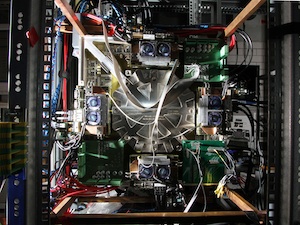As Moore's law is about to hit its limits, a new way to support the next phase of innovation in pattern recognition for vision systems, large datasets, machine learning, and a wealth of other use cases is dawning. This field is termed Neuromorphic engineering and there are number of interesting players in the market doing some pretty extraordinary things.
A few government projects leading this drive:
Darpa
BRAIN
The Human Brain Project
For a longer read on this topic see this excellent article from the Economist here (some of which is summarised below).
Hardware players
IBM
IBM alongside their Watson platform (the double jeopardy playing, pseudo doctor, and recipe wizard AI) is developing a hardware framework to supplement the growing need for a low power computer architecture that can 'think'.
IBM Neurosynaptic chips:
A great overview can be found over at the blog of IBM's Dahmendra Modha (Chief Scientist Brain-Inspired Computing).
University of Heidelberg
Work being undertaken at the University of Heidelberg has yielded a number of noteworthy hardware advances. Here are a few:
The neuromorphic waferscale system in Heidelberg, Jan 2013 (larger image)
These projects are part of the research effort funded predominantly by the Human Brain Project.
Qualcomm
Qualcomm is leading the charge in a space that is very much their own - bringing neural proccessing chips to the mobile, and ultimately wearable, market. They've even coined NPU (Neural Processing Unit) as the new module that will work alongside existing architecture. A video of a robotic device in action below:
Also - some more recent coverage here.
Cognimem
Cognimem (derives from Cognitive Memory) is a chip manufacturer specialising in high speed parallel pattern recognition. They are seemingly the only company with a commercial offering in the cognitive computing space, albeit their chips and solutions are not at the grand scale of IBM/University of Heidelberg. Cogniblox (shown below) is an example of one of their boards which contains 4096 neurons and is stackable to increase the size of the processing network.
 |
| http://www.cognimem.com/products/design-resources/CogniBlox/index.html |
Intel
Back in 2012 Intel proposed a low energy neuromorphic chip design based on valves that switch orientation based on the spin of electrons passing through them. It will be interesting to see if anything comes out of their design as the competition for commercially viable NPUs heats up.
 |
| http://www.technologyreview.com/view/428235/intel-reveals-neuromorphic-chip-design/ |
Stanford University
Fresh out of Stanford is a circuit board they're calling "Neurogrid" containing 1 million neurons and billions of synapses (28th April 2014). Gigaom raises interesting points about needing to have a neuroscientist to program it though - an area only IBM seems to be tackling head on with their concept of 'corelets'.
 |
| http://news.stanford.edu/pr/2014/pr-neurogrid-boahen-engineering-042814.html |
"The Neurogrid circuit board can simulate orders of magnitude more neurons and synapses than other brain mimics on the power it takes to run a tablet computer."
University of Manchester
The university of Manchester, also working as part of the Human Brain Project is working on a massively parallel computing platform inspired by the brain.
Other Innovation
A few more initiatives to take a look at from Institute of Neuroinformatics, HRL Laboratories, University of Southern California, and MIT that will likely see new developments over coming years.
All images, video, and brand names owned by the respective organisations as per links provided.
Updated: 29th April moved Stanford University out of "Other Innovation" as they went to press with their "NeuroGrid" circuit board.
Updated: 29th April moved Stanford University out of "Other Innovation" as they went to press with their "NeuroGrid" circuit board.


No comments:
Post a Comment